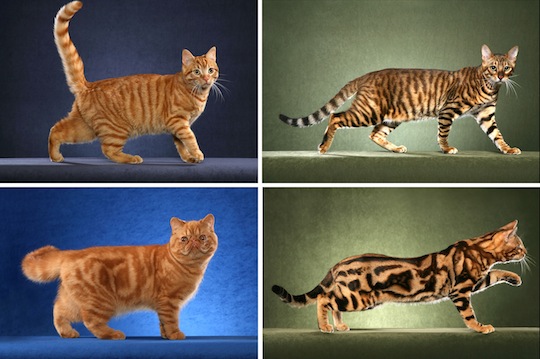Same Gene Guides Cheetah and Tabby Cat Coat Patterns
A mutation in one gene produces tabby cats with blotches and cheetahs with stripes
![]()

A genetic mutation determines whether a tabby cat is a mackerel (top row) or blotched (bottom row). (Image courtesy of Helmi Flick)
Tabby may be a colloquial term for a female kitty, but it’s more properly the name for the common stripey pattern on a domestic cat’s coat. Those tabby markings come in two main varieties: proper vertical stripes of dark on a light background, known as the mackerel pattern, and a blotched variety consisting of less-organized, dark whorls. Now scientists from Stanford University and elsewhere have identified the gene that determines whether a tabby is mackerel or blotched and found that the same gene also can make a cheetah a king. The study appears in today’s issue of Science.
“We were motivated by a basic question: How do periodic patterns like stripes and spots in mammals arise?” study co-author Gregory Barsh, an investigator at HudsonAlpha and a Stanford geneticist, said in a press release. “Until now, there’s been no obvious biological explanation for cheetah spots or the stripes on tigers, zebras or even the ordinary house cat.”
Barsh and his colleagues examined DNA taken from feral kitties in Northern California that were captured, sterilized and released (a common practice employed to control the size of feral cat populations) and from tissue samples collected by the City of Huntsville Animal Services group. All the mackerel tabbies they studied had a normal version of a gene the researchers named Transmembrane Aminopeptidase Q (Taqpep) while all the blotched tabbies had a mutated form of the gene.
The Taqpep gene establishes the pattern of a cat’s coat while a kitty is still in the womb, likely by determining the level of expression of another gene–Endothelin3 (Edn3)–that drives the shade produced by a hair cell (lots of Edn3 results in darker hair). The form of the pattern is actually established out of a random interaction of chemicals that ends up producing something that looks non-random–British mathematician Alan Turing first proposed this theory in 1952, and it was later simulated in computer models and earlier this year scientists discovered the chemicals in question.
Still to be determined, though, is why some domestic cats don’t have any pattern at all despite the status of their Taqpep gene. (On a side note, blotched tabbies are sometimes called “classic” tabbies but not because they’re more common. The blotched pattern is a more recent mutation; the original wild ancestors of domestic kitties were mackerels similar to Old World wild cats of today.)
But domestic cats aren’t the only cats that can vary in coat pattern, of course. Most cheetahs, for example, are the common spotted variety, but a few rare cats are known as king cheetahs, and these sub-Saharan kitties have dark stripes running along their backs (see below). When the researchers examined skin and blood samples taken from captive and wild cheetahs from South Africa and Namibia, they found that not only did the cats have the same Taqpep gene as domestic kitties, but also the gene worked in a similar way on the wild cats’ coats. A normal Taqpep gene produced the regular spotted cats but a mutated Taqpep merged the spots into stripes, just as the gene had merged the tabby stripes into blotches.
Though scientists cannot yet explain how the zebra got its stripes, at least now they can explain how the king cheetah got his.
/https://tf-cmsv2-smithsonianmag-media.s3.amazonaws.com/accounts/headshot/Sarah-Zielinski-240.jpg)

/https://tf-cmsv2-smithsonianmag-media.s3.amazonaws.com/accounts/headshot/Sarah-Zielinski-240.jpg)